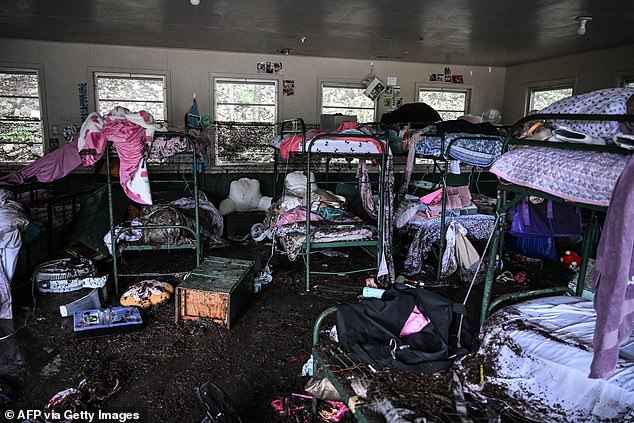
Dozens of people died in the catastrophic flooding that tore through central Texas last week, and now shocking new evidence suggests the tragedy may have been entirely avoidable.
Local officials in Kerr County rejected a proposal in 2017 to install a modern flood warning system along the Guadalupe River, saying its roughly $300,000 price tag was too ‘extravagant’ for the rural area.
That decision, critics say, left campers near Kerville vulnerable when predawn torrential downpours transformed the river into a deadly raging torrent in less than an hour on Friday.
Since the tragedy, a fiery debate has erupted about who was responsible. Some blame it on climate change, others say the Trump administration’s budget cuts hobbled weather forecasters.
But Texas academic Michael Shellenberger calls such claims ‘dishonest’ and ‘sensational,’ and accuses local officials of not installing a siren system in an area known as Flash Flood Alley.
‘The county had no formal flood warning system,’ said the politics professor, who says flooding deaths have been cut by 80 percent this past century thanks to planning and safety measures.
‘There were no sirens, no automated text alerts, no rapid evacuation protocol. The river rose and families had no idea it was coming.’
Hundreds of angry locals meanwhile have signed a petition demanding an ‘early warning siren system’ to give people some ‘critical extra minutes’ to evacuate the next time tragedy strikes.

A view inside a cabin at Camp Mystic, a Christian summer camp for girls, where flash floods claimed 27 lives

Angry locals have signed a petition demanding an early warning siren system, as a fierce debate ensues about whom to blame for the tragedy
Search teams braved warnings of more heavy rain and thunderstorms on Monday, looking for dozens of people still missing after a disaster that has killed more than 89 people, including 28 children.
Most of the dead were in the riverfront Hill Country Texas town of Kerrville, where 68 were killed. Some 27 adults and children died at a single site: Camp Mystic summer camp for Christian girls on the banks of the Guadalupe River.
State emergency management officials had warned on Thursday, ahead of the July Fourth holiday, that parts of central Texas faced flash floods based on National Weather Service (NWS) forecasts.
But twice as much rain as was predicted ended up falling over two branches of the Guadalupe River, leading to a deadly surge of 20 to 26 feet near Kerrville, City Manager Dalton Rice said.
There were no sirens or early flooding monitors, like the ones that reportedly blasted less than 20 miles away throughout Comfort, in Kendall County.
Instead, there were text alerts that came late for some residents and were dismissed or unseen by others.
Texas Governor Greg Abbott and other officials said the floods, weather forecasts and warning systems would be scrutinized once the immediate situation was brought under control.
Some experts questioned whether federal jobs cuts by the Trump administration led to a failure by NWS officials to predict the severity of the floods and issue warnings ahead of the storm.
The Trump administration has overseen thousands of cuts from the NWS’s parent agency, the National Oceanic and Atmospheric Administration, leaving offices understaffed, former NOAA director Rick Spinrad said.
President Donald Trump pushed back when asked on Sunday if cuts hobbled the disaster response, framing it as a rare ‘100-year catastrophe.’
On Monday, his Homeland Security Secretary Kristi Noem said there was no breakdown in warning systems and that the NWS had ‘put out the alerts when they received them.’
‘Would everybody like more time? Absolutely. So many situations when we see terrible events like this and these national weather disasters, more notification is always extremely helpful,’ Noem told Fox & Friends.
She said the weather service under Trump ‘has been working to put in new technology and a new system because it has been neglected for years,’ without elaborating on the new system.

Officials inspect recovery efforts at Camp Mystic along the Guadalupe River

Houses and cars are partially submerged in floodwaters in an aerial view near Kerrville, Texas, where dozens perished

Locals are now furious about a 2017 local decision against installing emergency alert sirens
Chuck Schumer, the top Democrat in the Senate, on Monday asked the Department of Commerce to investigate whether cuts affected the response to the Texas floods.
Texas Senator Ted Cruz on Monday also called for an investigation, saying campers should have been evacuated.
‘If we could go back and do it again, we would evacuate,’ the Republican said.
‘Particularly those in the most vulnerable areas – the young children in the cabins closest to the water, we would remove them and get them to higher ground, if we could go back and do it again.’
Critics say the bereaved families were let down by local policymakers.
In 2017, Kerr County officials debated whether to expand a warning system along its river, which was often packed with children’s summer camps.
But the $327,750 plan was rejected as too expensive for a county with an annual budget of around $67 million, despite its lengthy tragic record of flooding deaths.
The systems are simple networks of rain or stream gauges that are triggered when rain or floodwaters exceed a certain level.
They are linked to sirens, which quickly and loudly notify a community of threats to public safety, including severe weather.
A single siren can cost some $10,000 to $50,000, and multiple are sometimes needed.
A system of 14 emergency tornado sirens for nearby San Marcos cost $327,750, three quarters of which came from federal funds.
Critics say they’re expensive, require regular maintenance, are primarily designed to be heard outdoors and aren’t as effective as weather radios and mobile alerts.
H.A. ‘Buster’ Baldwin, a Kerr County commissioner at the time, called the plan a ‘little extravagant’ for a community of just 50,000 people.
‘Taking these funds out of special projects from the road and bridge department ticks me off a little bit,’ Baldwin said, according to the Kerrville Daily Times.

University of Austin professor Michael Shellenberger says bereaved families were let down by local policy makers

Shellenberger says climate alarmists are a ‘cult’ that blames all weather disasters on planet-heating gases without evidence
Tom Moser, a Kerr County commissioner at the time, said the real problem is alerting the public when a looming flash flood is detected.
‘We can do all the water-level monitoring we want, but if we don’t get that information to the public in a timely way, then this whole thing is not worth it,’ he said.
Those decisions eight years ago, and in council meetings since, appear wrongheaded after the holiday weekend floodwaters swept away vehicles, campers and even entire homes.
Nicole Wilson, 42, a Texas resident who is friends with moms of kids at the stricken camps, says sirens would have saved lives and has started an online petition to ‘urgently’ get leaders to act.
‘The tragic events at Camp Mystic and the devastating flooding… are stark reminders that severe weather can strike with little notice,’ Wilson wrote.
‘A well-placed siren system will provide critical extra minutes for families, schools, camps, businesses and visitors to seek shelter and evacuate when needed.’
Hundreds of people have signed the petition, including one user, Anthony, who called it ‘tragically obvious that a siren warning is needed for the most flash flood prone area of the country.’
Shellenberger also pushed back on claims in media outlets that Texas’ floods were caused by emissions of planet-heating gases making the weather more unpredictable and dangerous.
‘Over the past decade, reporters have increasingly blamed climate change for heat waves, hurricanes, wildfire, even cold snaps, often before any formal scientific attribution was possible,’ said the University of Austin professor.
‘In an era of collapsing ad revenue and declining public trust. Sensational stories about apocalyptic climate disasters generate clicks, shares and urgency.’





